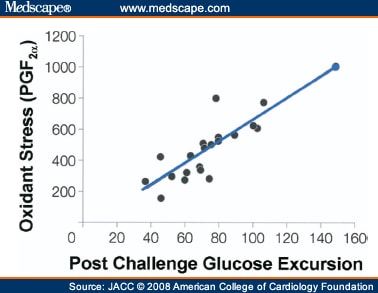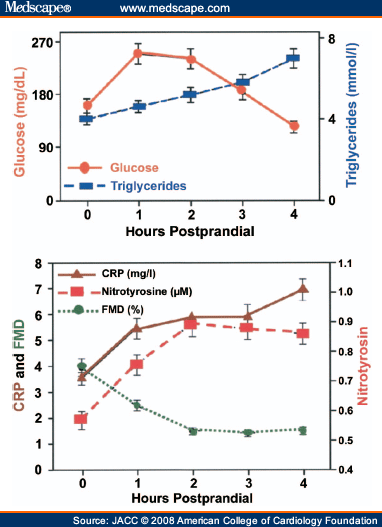Post-Prandial Hyperlipemia
Recent studies of healthy individuals indicate that a single meal high in saturated fat will cause immediate increases in triglycerides, oxidative stress, and inflammation, which causes corresponding post-meal worsening of endothelial dysfunction, vasoconstriction, and systolic blood pressure.[11,12] Post-prandial hyperlipemia, manifest as elevated levels of triglycerides, chylomicrons, and remnant lipoproteins, causes oxidative stress and inflammation, and independently potentiates the adverse effects of post-prandial hyperglycemia.[13] These elevated and protracted post-meal lipid levels are common manifestations of insulin resistance and the metabolic syndrome.[14]
Triglycerides are traditionally measured in the fasting state--typically the lowest triglyceride level of the day. Two large recently published cohort studies involving over 40,000 individuals found that post-prandial hypertriglyceridemia was associated with increased risk of CV events, whereas fasting triglyceride level was not.[15,16] Post-prandial triglyceride levels are also directly related to angiographic progression of coronary and carotid atherosclerosis.[3] Subanalyses of 3 randomized trials showed that lowering levels of elevated triglycerides by 20% to 40% reduced CAD rates by approximately 30% to 40%.[15
How the Modern Diet Causes Inflammation
Excessive ingestion of calorie-dense, easily digestible foods causes abnormal surges in blood glucose and triglyceride levels.[11–13] This bolus of energetic substrate overwhelms the metabolic capabilities of the mitochondria in the overnourished muscle and adipose tissues. Glucose and free fatty acids flood the Krebs cycle, stimulating an excess of the reduced form of nicotinamide adenine dinucleotide production, which outstrips the capacity of oxidative phosphorylation and drives the transfer of single electrons to oxygen, creating free radicals such as superoxide anion.[17] Post-prandial glucose excursion correlates directly with the ensuing increase in free radicals (Fig. 2). This post-prandial oxidant stress acutely triggers atherogenic changes, including increases in low-density lipoprotein oxidation, sympathetic tone, vasoconstriction, and thrombogenicity.[5,17] Meal-induced inflammation is evidenced by immediate increases in C-reactive protein, cytokines, and endothelin-1 (Fig. 3).[3,17] Even hyperglycemic spikes induced artificially using intravenous glucose infusions in lean nondiabetic individuals have been shown to markedly increase free radical generation.[18]
Figure 2.
 Glucose Excursion Directly Related to Oxidant Stress. Linear correlation between post-prandial glucose excursions and urinary excretion of 8-iso prostaglandin F2a (PGF2a), a measure of oxidant stress. Reprinted with permission [17]. Glucose Excursion Directly Related to Oxidant Stress. Linear correlation between post-prandial glucose excursions and urinary excretion of 8-iso prostaglandin F2a (PGF2a), a measure of oxidant stress. Reprinted with permission [17].
Figure 3.
 Post-Prandial Stress. The immediate deleterious effects of a beverage containing 75 g glucose mixed with 700 kcal/m 2 of whipping cream. Within 2 to 4 h glucose and triglyceride levels double, causing immediate oxidant stress (nitrotyrosine), inflammation (C-reactive protein [CRP]), resulting in deterioration in endothelial function. FMD % = percent flow-mediated dilation. Data from Ceriello et al.[41] Post-Prandial Stress. The immediate deleterious effects of a beverage containing 75 g glucose mixed with 700 kcal/m 2 of whipping cream. Within 2 to 4 h glucose and triglyceride levels double, causing immediate oxidant stress (nitrotyrosine), inflammation (C-reactive protein [CRP]), resulting in deterioration in endothelial function. FMD % = percent flow-mediated dilation. Data from Ceriello et al.[41]
|





 Glucose Excursion Directly Related to Oxidant Stress. Linear correlation between post-prandial glucose excursions and urinary excretion of 8-iso prostaglandin F2a (PGF2a), a measure of oxidant stress. Reprinted with permission [17].
Glucose Excursion Directly Related to Oxidant Stress. Linear correlation between post-prandial glucose excursions and urinary excretion of 8-iso prostaglandin F2a (PGF2a), a measure of oxidant stress. Reprinted with permission [17]. Post-Prandial Stress. The immediate deleterious effects of a beverage containing 75 g glucose mixed with 700 kcal/m 2 of whipping cream. Within 2 to 4 h glucose and triglyceride levels double, causing immediate oxidant stress (nitrotyrosine), inflammation (C-reactive protein [CRP]), resulting in deterioration in endothelial function. FMD % = percent flow-mediated dilation. Data from Ceriello et al.[41]
Post-Prandial Stress. The immediate deleterious effects of a beverage containing 75 g glucose mixed with 700 kcal/m 2 of whipping cream. Within 2 to 4 h glucose and triglyceride levels double, causing immediate oxidant stress (nitrotyrosine), inflammation (C-reactive protein [CRP]), resulting in deterioration in endothelial function. FMD % = percent flow-mediated dilation. Data from Ceriello et al.[41]